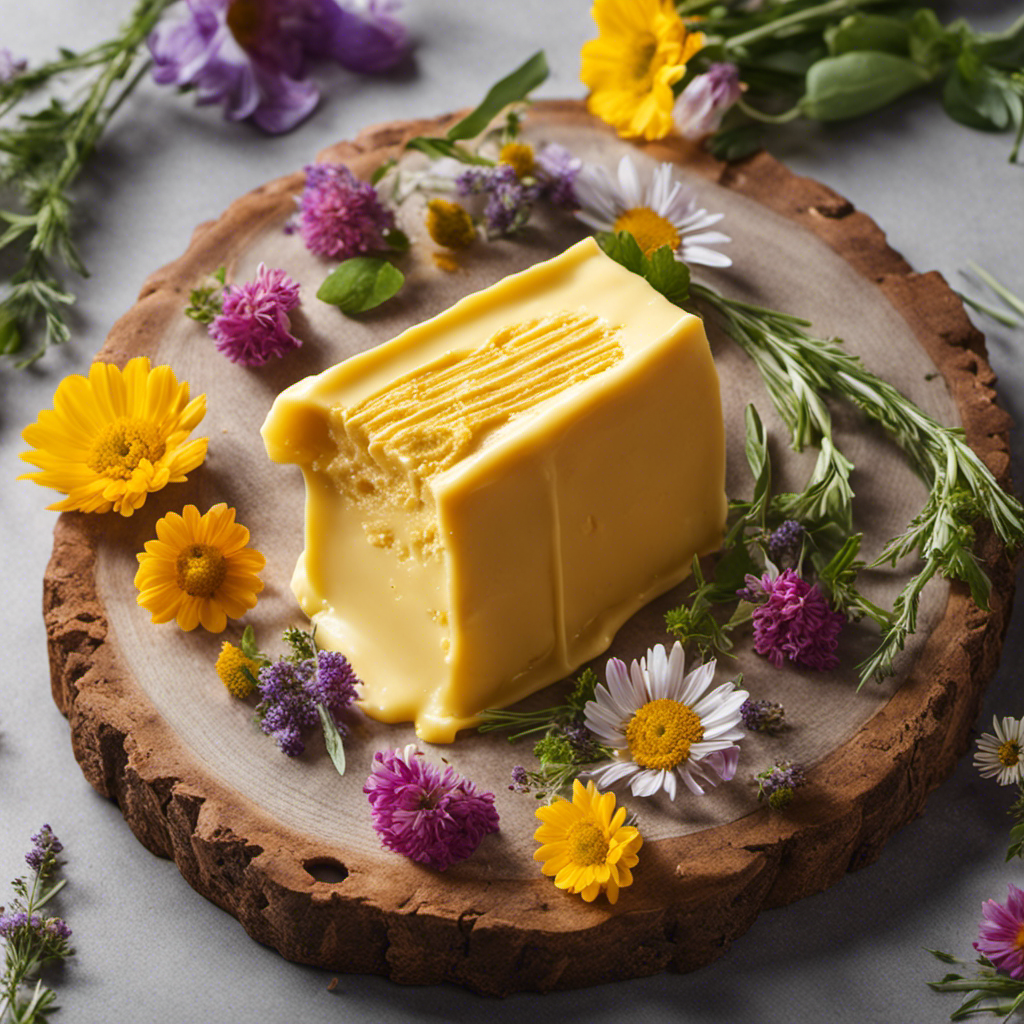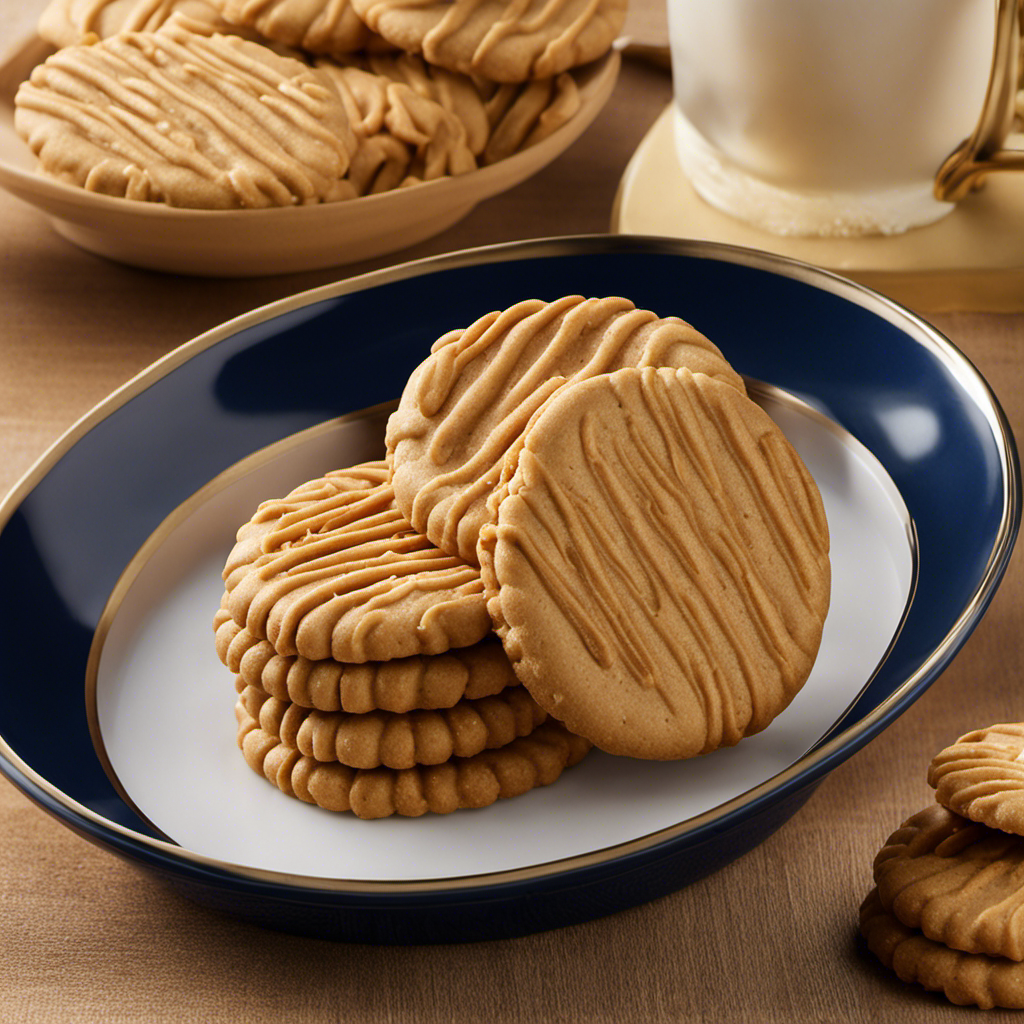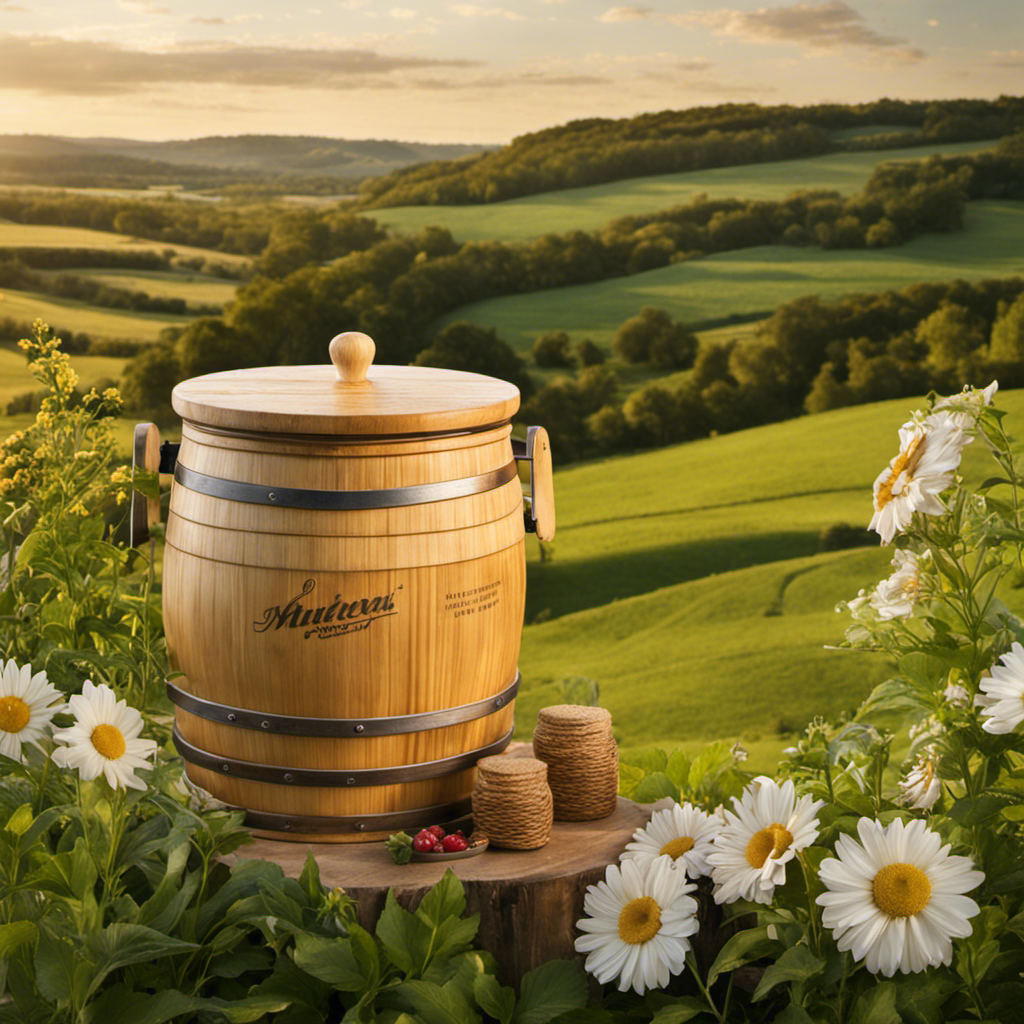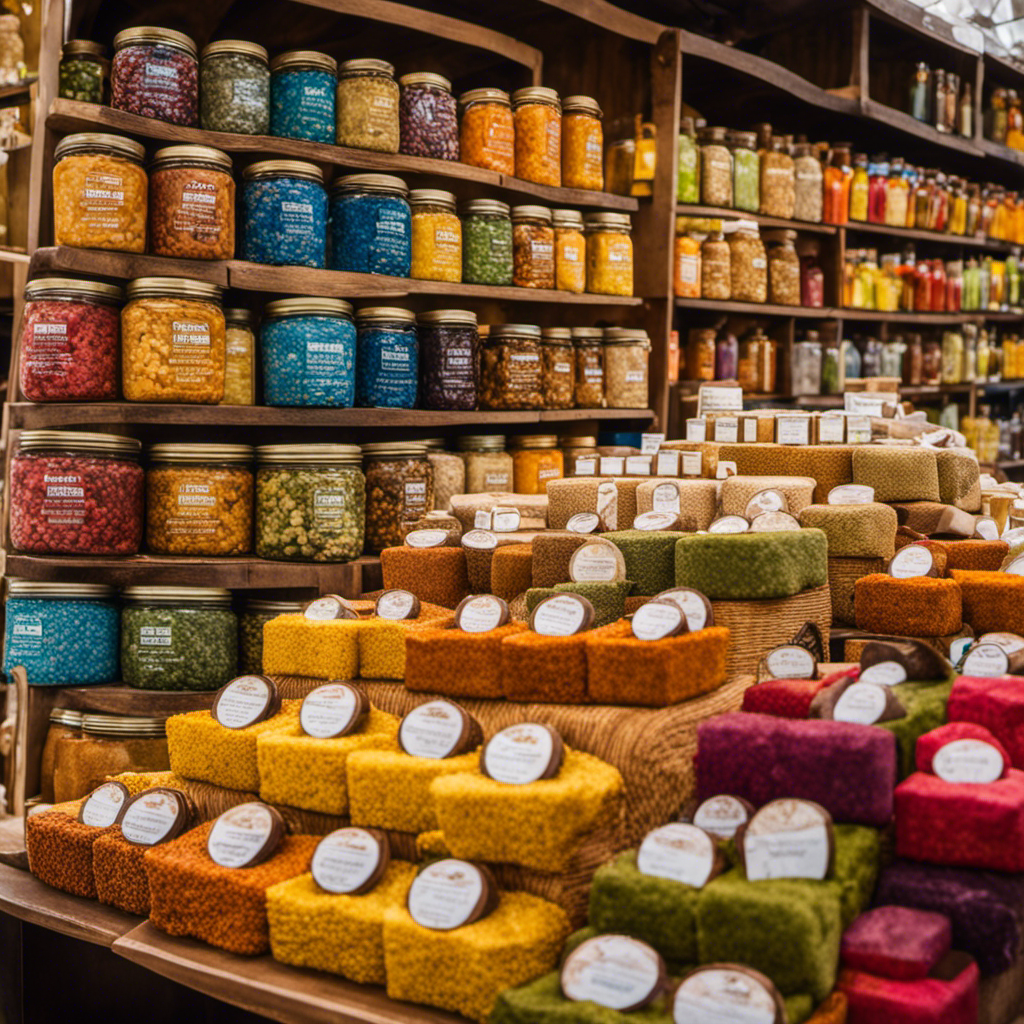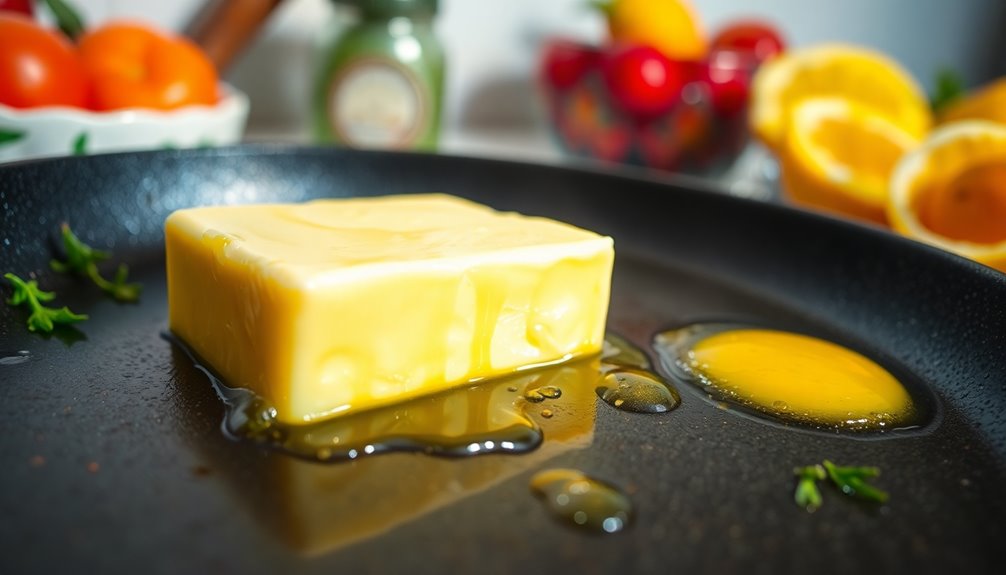As an enthusiastic lover of all things culinary, I have always been fascinated by how a simple ingredient can transform a dish. When it comes to flavor, few things can compare to the importance of butter.
But have you ever wondered what makes that buttery taste so irresistible? In this article, we will delve into the fascinating world of natural butter flavor.
From its origins to its health benefits and everything in between, join me on this journey of unraveling the secrets behind this delectable essence.
Key Takeaways
- Natural butter flavor is created through the isolation and synthesis of specific molecules responsible for the taste and aroma of butter.
- It is produced using steam distillation, where volatile compounds are extracted from heated butter and condensed to create a concentrated flavoring.
- Natural butter flavor is commonly used to enhance the taste of baked goods, savory spreads, sauces, gravies, and popcorn, providing a rich and delicious taste without actual butter.
- Vegan butter alternatives, such as Earth Balance, Miyoko’s Creamery, Nutiva, and Country Crock Plant Butter, offer a creamy and flavorful option for vegan, dairy-free, and plant-based diets, with lower saturated fat content and potential fortification with vitamins and minerals.
Origins of Natural Butter Flavor
The origins of natural butter flavor can be traced back to the early 20th century. It all started when scientists began to study the chemical compounds that contribute to the characteristic taste and aroma of butter. Through careful analysis and experimentation, they were able to identify the specific molecules responsible for these sensory attributes.
These molecules were then isolated and synthesized to create a concentrated form of natural butter flavor. This breakthrough had a significant cultural impact, as it allowed for the creation of various food products that could mimic the taste and aroma of butter without the need for actual butter.
This made it possible to produce butter-flavored snacks, spreads, and other culinary products that could be enjoyed by a wider range of people.
How Natural Butter Flavor Is Made
To make natural butter flavor, you’ll need to start with real butter. However, for those who are looking for dairy-free alternatives or want to incorporate the flavoring in snacks that need to be shelf-stable, there are other options available.
One common method involves extracting the essence of butter through a process called steam distillation. This technique involves heating the butter and collecting the steam that carries the volatile compounds responsible for its distinctive taste and aroma. Once captured, these compounds are then condensed and purified to create a concentrated butter flavoring.
This natural butter flavor can then be used in a variety of applications, such as in dairy-free spreads, baked goods, or even popcorn seasoning. With this method, even those with dietary restrictions can enjoy the rich and delicious taste of butter in their favorite snacks.
Common Uses for Natural Butter Flavor
If you’re wondering how to use it, natural butter flavor can enhance the taste of various dishes, from baked goods to savory spreads. It is a versatile ingredient that can add a rich and creamy flavor to your favorite recipes. One popular use for natural butter flavor is in popcorn. By adding a sprinkle of this flavoring, you can take your popcorn to the next level, giving it that irresistible buttery taste. Another common use for natural butter flavor is as a flavoring for sauces. Whether you’re making a creamy pasta sauce or a savory gravy, adding a touch of natural butter flavor can elevate the taste and give it a deliciously indulgent twist.
| Uses in Popcorn | Flavoring for Sauces |
|---|---|
| Enhances taste | Adds richness |
| Irresistible | Elevates flavor |
| Versatile | Deliciously indulgent |
| Sprinkle | Touch |
| Popular | Elevates |
Health Benefits of Natural Butter Flavor
Adding natural butter flavor to your dishes can enhance the taste and provide a healthier alternative to traditional butter. Natural butter flavor is a versatile ingredient that can be used in a variety of culinary applications.
It has a rich and creamy taste that mimics the flavor of real butter, making it a popular choice for those looking to reduce their intake of saturated fats. In terms of its nutritional profile, natural butter flavor is typically low in calories and contains no cholesterol. It is also often free from trans fats and can be a good source of essential fatty acids.
When used in cooking, natural butter flavor can add depth and richness to sauces, soups, and baked goods. It can also be used to enhance the flavor of vegetables, popcorn, and even coffee.
With its numerous culinary applications and health benefits, natural butter flavor is a great addition to any kitchen.
Alternative Options to Natural Butter Flavor
When looking for healthier alternatives, there are other options available besides natural butter flavor. If you’re looking for a dairy-free alternative, margarine can be a suitable option. Margarine is made from vegetable oils and is often fortified with vitamins and minerals. It has a similar texture to butter and can be used in cooking and baking.
However, it is important to note that margarine may contain trans fats, which can be detrimental to heart health. Natural butter flavor, on the other hand, is a flavoring agent that is derived from dairy and can be used to impart a buttery taste to various dishes.
It does not provide the same nutritional benefits as margarine, but it can be a good option for those who are not lactose intolerant or following a dairy-free diet.
Cooking and Baking Tips for Using Natural Butter Flavor
Cooking and baking with natural butter flavor can enhance the taste of your dishes and add a rich, creamy element. It is a versatile flavoring agent that can be used in a variety of cooking techniques and paired with different flavors to create delicious dishes. Here are some tips for using natural butter flavor in your cooking:
-
Use it in sauces and gravies: Natural butter flavor can be added to sauces and gravies to give them a rich and creamy taste. It works well in both savory and sweet sauces.
-
Enhance baked goods: Add a few drops of natural butter flavor to your cake, cookie, or pastry recipes to add a buttery taste. It can also be used in frosting and glazes.
-
Pair it with other flavors: Natural butter flavor pairs well with flavors like vanilla, cinnamon, and nutmeg. Experiment with different combinations to create unique and delicious dishes.
Here is a table showcasing some popular flavor pairings with natural butter flavor:
| Flavor Pairing | Description |
|---|---|
| Vanilla | Adds a sweet and creamy taste |
| Cinnamon | Enhances the warm and spicy flavors |
| Nutmeg | Adds a nutty and aromatic element |
Incorporating natural butter flavor into your cooking and baking can elevate the taste of your dishes and add a touch of indulgence. Experiment with different techniques and flavor combinations to create mouthwatering results.
Exploring Different Varieties of Natural Butter Flavor
When it comes to vegan butter alternatives, there are a variety of options available that can satisfy both taste and dietary preferences. These alternatives are typically made from plant-based oils such as coconut, avocado, or olive oil, and are often fortified with essential vitamins and minerals.
While vegan butter substitutes may lack the same flavor profile as traditional butter, they can still provide a rich and creamy texture to dishes. However, it is important to consider the health benefits of butter flavor, as some substitutes may contain high levels of saturated fats or additives.
Vegan Butter Alternatives
If you’re looking for a vegan alternative to butter, you should try out some of the delicious options available on the market today. Vegan butter substitutes are plant-based spreads that mimic the taste and texture of traditional butter, but without any animal-derived ingredients. These substitutes are perfect for those following a vegan or dairy-free diet, or anyone looking to reduce their consumption of animal products. Here is a comparison table of some popular vegan butter alternatives:
| Brand | Ingredients | Availability |
|---|---|---|
| Earth Balance | Vegetable oils, emulsifiers, natural flavors | Widely available |
| Miyoko’s Creamery | Cashews, coconut oil, cultures | Specialty stores, online |
| Nutiva | Coconut oil, palm fruit oil, sunflower lecithin | Health food stores, online |
| Country Crock Plant Butter | Algae oil, avocado oil, olives, and faba bean protein | Supermarkets |
These vegan butter substitutes can be used in baking, cooking, and spreading, providing a creamy and flavorful option for all your culinary needs. Give them a try and discover a whole new world of plant-based alternatives.
Health Benefits of Butter Flavor?
To get the health benefits of a butter-like taste, you might want to consider exploring vegan butter alternatives. These alternatives can provide a similar flavor and texture to butter, while offering additional health benefits.
One of the main advantages of vegan butter alternatives is their lower saturated fat content. Traditional butter is high in saturated fat, which can increase the risk of heart disease. In contrast, vegan butter alternatives are typically made from plant-based oils, such as coconut or olive oil, which contain healthier fats.
Additionally, these alternatives may be fortified with vitamins and minerals, providing added nutritional value. Some vegan butter alternatives also contain omega-3 fatty acids, which are important for heart and brain health.
Overall, incorporating vegan butter alternatives into your diet can be a smart choice for those seeking the health benefits of a butter-like taste.
Frequently Asked Questions
Are There Any Potential Allergens or Intolerances Associated With Natural Butter Flavor?
There may be potential allergens or intolerances associated with natural butter flavor. It is important to be aware of these potential health risks and to consider the nutritional value when consuming products with natural butter flavor.
Can Natural Butter Flavor Be Used in Vegan or Dairy-Free Recipes?
Yes, natural butter flavor can be used in vegan or dairy-free recipes as a substitute for butter. It provides the rich, creamy taste without the use of animal products, making it a great choice for those following a vegan or dairy-free lifestyle.
How Long Can Natural Butter Flavor Be Stored and What Is the Best Way to Store It?
The shelf life of natural butter flavor varies depending on the manufacturer, but it is typically around 1-2 years. To ensure freshness, store it in a cool, dry place away from sunlight and strong odors.
Are There Any Specific Recipes or Dishes That Pair Particularly Well With Natural Butter Flavor?
There are several pairing ideas for natural butter flavor, such as using it in baked goods like cookies or muffins, or adding it to mashed potatoes for a rich and creamy taste. Additionally, natural butter flavor has health benefits, as it is a source of healthy fats and can enhance the flavor of low-fat or plant-based dishes.
Is Natural Butter Flavor Safe for Consumption by Children and Pregnant Women?
Natural butter flavor is safe for consumption by children and pregnant women. It undergoes rigorous safety testing and adheres to strict regulations. Additionally, it provides the delicious taste of butter without the potential health risks associated with consuming excessive amounts of saturated fats.
Conclusion
In conclusion, natural butter flavor is a popular ingredient used in various food products to enhance taste and aroma. It is made through a process that involves extracting the natural compounds found in butter and combining them with other natural ingredients.
One interesting statistic to note is that the global natural flavor market is projected to reach a value of $9.3 billion by 2025. This highlights the growing demand for natural flavors, including natural butter flavor, as consumers seek healthier and more natural food options.
